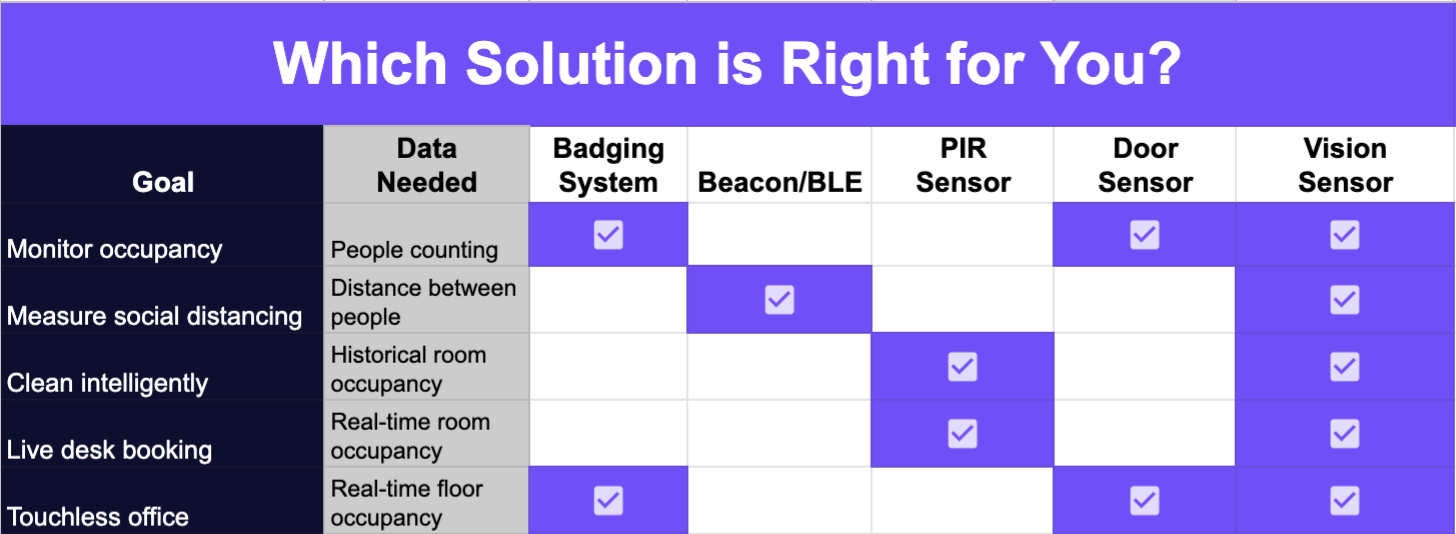Back to the Office: A Sensor & Proptech Buyer’s Guide

VergeSense is the industry leader in providing enterprises with a true understanding of their occupancy and how their offices are actually being used.
Companies around the world have relied on technology to capture occupancy data and manage space for years. Today, solutions like VergeSense are at the center of their strategies to return to work safely.
Choosing the right sensors is not easy. Over the last few years, and even in the last few months in response to the COVID-19 crisis, numerous technology vendors have entered the market offering new solutions.
These solutions include PIR and door sensors, BLE beacons, more modern computer vision-based technologies and even badging systems. The technology is sophisticated, and with many different options on the market, it’s essential to understand the capabilities (and gaps) with each solution type.
Like anything, it’s about matching the best tool for the job. And these current jobs are among the most critical the business world has ever faced. Here is how each sensor technology stacks up for tackling these tasks:

Monitoring Occupancy
The people counting that informs occupancy data has always been a significant use case for workplace sensors. However, that need is more critical than ever as C-suite executives need a way to accurately monitor occupancy to stay compliant with new regional maximum occupancy limits and OSHA requirements for re-opening workplaces.
Badging System: A badging system typically relies on Near Field Communication (NFC) or RFID (Radio Frequency Identification) for access control. These systems offer entrance security and people counting by utilizing three data points: the employee badge number, the location of the receiver, and the time of the badge scan. Badging systems can keep count of when workers arrive and leave. However, they are susceptible to inaccuracies (for example: tailgating). They may also be considered an inconvenience by employees who need to keep on hand.
Beacon/BLE: A Bluetooth enabled beacon or sensor transmits a universally unique identifier to nearby devices with a compatible application. The connection can be used to track object movement or pinpoint where a device is. Beacons are technically capable of collecting information on employee occupancy via their BLE-enabled phones.
PIR Sensor: Short for Passive infrared (PIR) sensors, this technology detects heat and movement. The placement of PIR occupancy sensors is very particular and works best for screening entries. They do not work very well in the modern office, given the growing reliance on open concepts that limit the number of doorways. Furthermore, common problems with PIR sensors lead to a decrease in the accuracy rate when people are stationary for extended periods. That means that these sensors can struggle to detect the specific amount of people in a particular space in real-time.
Door Sensor: These sensors, which can rely on PIR, thermal, or depth technology, track movement through a specific doorway. They can be used to see how many people are in a space with a single entry and exit point, such as conference rooms. Still, they often provide incomplete information and little opportunity to analyze trends from a broad perspective.
Vision Sensor: Capture raw low-resolution optical data at regular intervals and use computer vision technology to translate these images into data points. The result is a highly accurate person count in any space and a complete analysis of true occupancy in a variety of space types, beyond entryways.
Measuring Social Distancing
As we get back to work, companies will need to understand how employees interact with workspaces and how they engage with their coworkers. In the past, workplace strategists designed space for ‘workplace collisions’. The metric was a positive one, which showed office and employee engagement. However, in the post-COVID-19 workplace, these collisions can be unhealthy. Most companies are proactively rearranging their offices to limit exposure and ensure compliance with social distancing guidelines.
Badging System: Do not provide data on the distance between employees.
Beacon/BLE: Recent press describes how Apple and Google are exploring the use of BLE-enabled phones for contact tracing to prevent further virus spread. However, using BLE to measure the distance between employees requires careful privacy consideration. For this type of technology to be deployed successfully, employees typically must grant consent and companies will want vendors to provide assurance on how personally identifiable information is stored.
PIR Sensor: Do not provide data on the distance between employees.
Door Sensor: Do not provide data on the distance between employees.
Vision Sensor: Vision sensors are uniquely capable of capturing anonymous data about the distance between people throughout the entire office. VergeSense sensors can calculate where and when people tend to interact and locations where it may be more difficult to practice safe social distancing. Companies can use the VergeSense Social Distancing Score to easily monitor how adjustments in working hours, staggered shifts, room closures, and employee communications can facilitate social distancing. Leveraging this data, organizations can make informed, data-driven adjustments to their workplace re-entry strategy.
Cleaning Intelligently
Optimizing cleaning budgets will be imperative as some have already grown to be more than 3X during the response to the crisis. Sensors can be helpful here to identify more frequently trafficked areas that require more frequent cleaning.
Badging System: Do not provide the room occupancy data needed to generate cleaning plans nor sync with IWMS to manage cleaning efforts.
Beacon/BLE: Technically possible, but requires privacy considerations. Using a bluetooth- enabled beacon to pinpoint workspaces that require cleaning is possible, but as mentioned above, there are significant privacy concerns that would need to be addressed by both leaders and employees before it is deployed.
PIR Sensor: PIR sensors detect occupancy through body heat and motion. They may be less accurate on the desk-level or spaces, like conference rooms, of prolonged use.
Door Sensor: Do not provide the room occupancy data needed to generate cleaning plans or sync with IWMS to manage cleaning efforts.
Vision Sensor: Real estate and facilities teams are increasingly relying on vision sensors to access the most accurate, floor map of the most frequently used spaces throughout the day. Companies can use the VergeSense dashboard to generate cleaning plans or sync occupancy data to their IWMS to manage cleaning efforts appropriately.
Live Desk Booking: With companies like Google and Twitter issuing optional WFH policies through the end of 2020 or indefinitely, it’s accelerating the need for ways to reserve desks in advance and calculate for a highly variable daily headcount.
Badging System: Do not provide real-time desk occupancy data.
Beacon/BLE: BLE beacons placed on desks could make this technically possible, but as they would need to communicate with employees BLE-enabled phones there would be privacy concerns.
PIR Sensor: Considering these sensors grapple with detecting people who are stagnant over a longer period of time, its data tends to be less accurate at desk-level.
Door Sensor: Do not provide real-time desk occupancy data.
Vision Sensor: Companies rely on these sensors for obtaining highly accurate live desk and room occupancy data to power room booking and other 3rd party employee-facing applications. In addition, VergeSense has leveraged image-to-data technology to develop a proprietary computer model that can count personal items left behind, such as backpacks, laptops, and clothing, and register these signs of life as spaces that are passively occupied.
Creating A Touchless Office
Companies around the world are looking to limit contact with shared surfaces such as doors and kiosks for reserving rooms and workspaces. Certain types of sensors can enable a touchless office by providing automated door opening and real-time occupancy data for contactless booking.
Badging System: Can provide touchless entry into an office or workplace by automating door doors to open, enabling passage through a turnstile, or simply passing by a receiver at an open entry point. However, given badging system receivers are only typically placed at an entry point to a building, they are not suitable for other forms of touchless entry or booking.
Beacon/BLE: Utilizing Beacon-enabled sensors is technically possible in this category as they could automate touchless entry and booking via communication with employees BLE-enabled phones. However, once again, there are privacy concerns to consider.
PIR Sensor: Do not provide real-time occupancy data, but they can be utilized to capture motion detection for automating door entry.
Door Sensor: Although door sensors can struggle to provide real-time occupancy data for booking a large workspace with multiple entry and exit points, they can provide fairly accurate data for touchless booking of rooms with single entry and exit points. Given these sensors are typically installed overhead or within door areas they can also be used to automate door opening as someone arrives in front of a doorway.
Vision Sensor: These sensors capture highly accurate live desk and room occupancy data to power a touchless office experience. VergeSense’s computer vision sensors integrate with room booking and other 3rd party employee-facing applications. This enables auto-check-in of rooms, desks, and more for a hands free experience. Also, VergeSense’s people counting ability can be integrated into access control systems to automate entry and exits.
Finally, many companies are considering thermal sensing to check employee temperature at entrances. Given that many people with COVID are asymptomatic, thermal sensors have limited value. We have however seen a renewed interest in improving indoor environmental quality and monitoring indoor environmental quality to ensure that VOCs, CO2, humidity, and temperature levels do not contribute to spreading the virus. While specialized humidity sensors and CO2 sensors exist in the market, multi-factor environmental sensors that measure IEQ and occupancy are still fairly limited and a category VergeSense is currently developing.
So as you look for a sensor to power screening employees, monitoring occupancy, measuring social distancing, cleaning intelligently, and improving indoor environmental quality, which sensor technology will you opt for?
With the ability to screen employees, monitor occupancy, measure social distancing, clean intelligently, and add-on environmental features, VergeSense’s vision sensors will help you safely navigate the return to the Post-COVID-19 workplace. Our sensors are available as both wired and wireless, and operate independently of your existing IT network. To learn more, schedule a demo today.